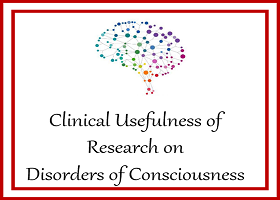Clinical Usefulness of Research on Disorders of Consciousness
A special issue of Brain Sciences (ISSN 2076-3425). This special issue belongs to the section "Behavioral Neuroscience".
Deadline for manuscript submissions: closed (31 December 2021) | Viewed by 52112

Special Issue Editors
Dipartimento di Studi Umanistici (DISTUM), Università degli Studi di Urbino Carlo Bo, Urbino, Italy.
Interests: Disorders of consciousness; Neurological disorders; Brain imaging; Resting-state fMRI.
Interests: Consciousness; Disorders of consciousness; Clinical evaluation; Severe acquired brain injury; Disability; Rehabilitation; Sleep; Theories of consciousness
Special Issue Information
Dear Colleagues,
Disorders of consciousness (DOC) refer to clinical conditions that follow a severe brain injury ranging from coma, to vegetative state/unresponsive wakefulness state (VS/UWS) and minimally conscious state (MCS). DOC represent one of the least understood and most ethically troublesome conditions, and a growing number of studies have been investingating this topic.
Diagnosis, prognosis, planning of rehabilitation and care programs pose major challenges as the clinical assessment at the bedside is notoriously difficult, particularly between VS/UWS and MCS.
In the last decades different techniques, mainly adopting neuroimaging and neurophysiological methods, have been developed and applied on DOC patients to complement clinical valuation and assess residual consciousness and cognitive functions. Several studies using multiple techniques such as structural MRI, functional MRI with active tasks and resting-state paradigm, diffusion MRI, PET, or EEG, ERPs, TMS, tDCS and other methods highlighted the importance of using conventional and advanced techniques to study DOC.
At this point, it is important to assess the clinical impact of these research studies on DOC with the aim of translating recent advances into clinical practice.
In this context, this Special Issue aims to collect research articles that attempt to take a step forward in understanding DOC providing a clinical contribution.
Original papers as well as reviews focuing on the clinical impact of research on DOC are welcome.
Dr. Cristina Rosazza
Dr. Davide Sattin
Guest Editors
Manuscript Submission Information
Manuscripts should be submitted online at www.mdpi.com by registering and logging in to this website. Once you are registered, click here to go to the submission form. Manuscripts can be submitted until the deadline. All submissions that pass pre-check are peer-reviewed. Accepted papers will be published continuously in the journal (as soon as accepted) and will be listed together on the special issue website. Research articles, review articles as well as short communications are invited. For planned papers, a title and short abstract (about 250 words) can be sent to the Editorial Office for assessment.
Submitted manuscripts should not have been published previously, nor be under consideration for publication elsewhere (except conference proceedings papers). All manuscripts are thoroughly refereed through a single-blind peer-review process. A guide for authors and other relevant information for submission of manuscripts is available on the Instructions for Authors page. Brain Sciences is an international peer-reviewed open access monthly journal published by MDPI.
Please visit the Instructions for Authors page before submitting a manuscript. The Article Processing Charge (APC) for publication in this open access journal is 2200 CHF (Swiss Francs). Submitted papers should be well formatted and use good English. Authors may use MDPI's English editing service prior to publication or during author revisions.
Keywords
- Disorders of Consciousness
- Consciousness
- Clinical assessment
- Diagnosis
- Prognosis
- Treatment
- Brain Imaging
- Neurophysiological techniques
Benefits of Publishing in a Special Issue
- Ease of navigation: Grouping papers by topic helps scholars navigate broad scope journals more efficiently.
- Greater discoverability: Special Issues support the reach and impact of scientific research. Articles in Special Issues are more discoverable and cited more frequently.
- Expansion of research network: Special Issues facilitate connections among authors, fostering scientific collaborations.
- External promotion: Articles in Special Issues are often promoted through the journal's social media, increasing their visibility.
- Reprint: MDPI Books provides the opportunity to republish successful Special Issues in book format, both online and in print.
Further information on MDPI's Special Issue policies can be found here.






